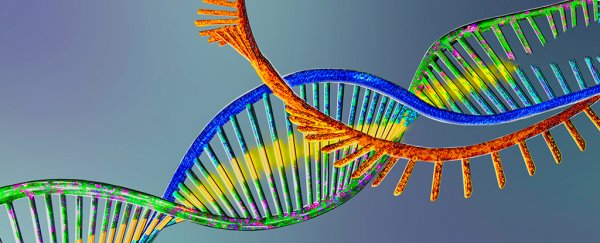In an effort to trace a pathway from non-evolving organic chemistry to the first truly living cells, scientists from Harvard Medical School in Massachusetts have proposed those early building blocks contained little-known nucleic acids that aren't part of any modern genome.
The question of how we evolved genomic libraries encoded in DNA that are managed by protein-based enzymes and transcribed into notes of short-lived lengths of RNA is fundamental to understanding how life arose on Earth.
The building blocks for both of these ubiquitous chemicals could easily have been present under the hostile conditions on our newborn planet.
But based on what we know of the chemistry giving rise to the well-known nucleic acids RNA and DNA, there's plenty of room for the possibility that other variations could also have formed in the mix.
To understand how this mixture might have behaved, researchers produced nucleotide recipes based on hybrid mixes of not just the familiar ribonucleic (RNA) and deoxyribonucleic acids (DNA), but a sprinkle of something called arabinonucleic acid, or ANA.
The difference between the three different nucleic acids is as subtle as an absent oxygen or a flipped hydroxyl group on the sugar forming the molecule's core.
As small as these contrasts might be, they can make all the difference when it comes to the stability of the polymers they each form under various conditions. Different types of nucleic acids can also mix to form hybrid codes, some of which are more prone to breaking apart than others.
The researchers found when it came to self-replicating, strings of pure RNA did a much better job than other forms of pure nucleic acid, outcompeting them in terms of not just speed, but precision and efficiency.
Surprisingly, by having certain combinations of DNA/ANA hybrids in the environment, RNA did an even better job at replicating, a finding that addresses a long-standing criticism of what's referred to as the RNA World Hypothesis.
Back in the 1960s biologists Carl Woese, Francis Crick, and Leslie Orgel pointed out that RNA had a knack for doing two jobs in one. Even today, it's seen acting as both a means of encoding and performing physical tasks in a cell.
This meant RNA could serve as a convenient prologue for life, forming the basis of an ' RNA world' of competing nucleic acid sequences by playing the role of instruction guide and photocopier.
Unfortunately, 'convenient' is the key word here. Just how did RNA come to be king when surrounded by look-a-likes that could clutter up its machinery?
"Years ago, the naive idea that pools of pure concentrated ribonucleotides might be present on the primitive Earth was mocked by Leslie Orgel as 'the Molecular Biologist's Dream'," says Harvard chemical biologist and Nobel Prize Laureate Jack Szostak.
"But how relatively modern homogeneous RNA could emerge from a heterogeneous mixture of different starting materials was unknown."
Several years ago, Szostak and his team found evidence that hybrid strings of RNA and DNA could help to explain why DNA eventually came to dominate our genomes, in spite of RNA's dual talents.
This newest research complements the discovery by again showing we don't need to explain how RNA or DNA arose separately in their own wet pockets of chemistry.
"No primordial pool of pure building blocks was needed," says Szostak.
What's more, having other types of nucleic acid around – including ones no longer being employed by living machines – could have actually helped strands of pure RNA dominate, allowing them to take on the most basic tasks of biology and represent a primitive form of life.
"The intrinsic chemistry of RNA copying chemistry would result, over time, in the synthesis of increasingly homogeneous bits of RNA," says Szostak.
Future work could show how other nucleic acids interacted with the burgeoning biochemistry, filling in potential details on life's origins as a chimera of DNA, RNA, ANA, and possibly even other variants we can currently only dream up in a lab.
While we can only speculate on how life arose on Earth several billion years ago, finding evidence of our origins could help us to understand how life might arise elsewhere in the cosmos, not to mention how we might go about creating synthetic alternatives to biology back here on our home planet.
At this rate, we might need to consider the RNA World Hypothesis as NA.
This research was published in the Journal of American Chemical Society.
